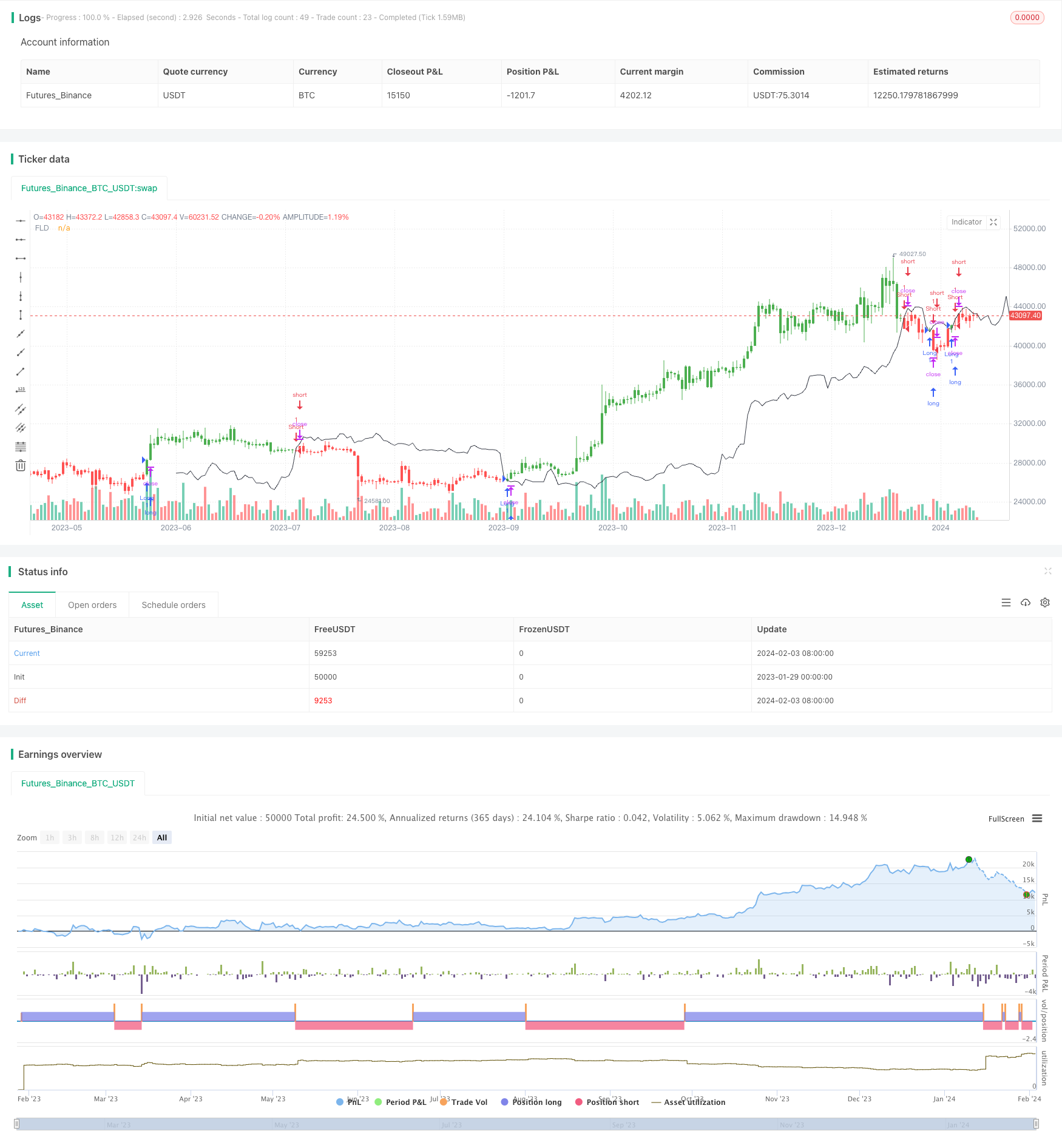
概述
该策略的主要思想是通过绘制未来价格延伸线,并结合当前价格与该线的关系,判断未来价格的方向。当价格高于或低于延伸线时,可以相应做多或做空。
策略原理
未来价格延伸线(Future Lines of Demarcation,FLD)代表着未来特定周期内的中位价、最高价或最低价。该策略运用FLD判断价格未来走势,其原理是:
- 根据周期长度,计算出FLD的位移周期Period,即Price的未来价格。
- 比较当前Close价格与FLD位移周期后的价格。
- 当Close价格低于FLD未来价格,判断为看涨信号。
- 当Close价格高于FLD未来价格,判断为看跌信号。
- 根据看涨和看跌信号,进行相应的做多做空操作。
优势分析
该策略主要优势有:
- 使用FLD判定未来价格走势,准确率较高。
- 可自定义周期参数,适用于不同市场环境。
- 可选择中位价、最高价或最低价作为FLD绘制源,适应性强。
风险分析
该策略主要风险有:
- FLD本身可能失效,导致错失机会或错误信号。可以结合其他指标判断。
- 周期参数设置不当,可能导致过多错误信号。需要优化周期长度。
- 突发事件导致价格急剧波动,FLD预测失效。可以设置止损来控制风险。
优化方向
该策略可从以下方面进行优化:
- 结合其他指标过滤信号,提高策略准确率。比如MACD,KDJ等。
- 优化周期参数,找到最佳参数组合。
- 增加止损止盈机制,控制单笔亏损和盈利。
- 根据回测结果,调整做多做空规则,减少错误信号。
总结
该策略通过比较价格与位移后的未来价格延伸线,判断价格未来走势方向,属于典型的趋势跟踪策略。总体来说逻辑清晰易懂,实施风险较小。通过参数优化和指标组合,可以获得较好的策略效果。
策略源码
/*backtest
start: 2023-01-29 00:00:00
end: 2024-02-04 00:00:00
period: 1d
basePeriod: 1h
exchanges: [{"eid":"Futures_Binance","currency":"BTC_USDT"}]
*/
//@version=2
////////////////////////////////////////////////////////////////////
// Copyright by HPotter v1.0 15/02/2017
// An FLD is a line that is plotted on the same scale as the price and is in fact the
// price itself displaced to the right (into the future) by (approximately) half the
// wavelength of the cycle for which the FLD is plotted. There are three FLD's that can be
// plotted for each cycle:
// An FLD based on the median price.
// An FLD based on the high price.
// An FLD based on the low price.
///////////////////////////////////////////////////////////////////
strategy(title="FLD's - Future Lines of Demarcation", overlay=true)
Period = input(title="Period", defval=40)
src = input(title="Source", defval=hl2)
reverse = input(false, title="Trade reverse")
FLD = src
pos = iff(FLD[Period] < close , 1,
iff(FLD[Period] > close, -1, nz(pos[1], 0)))
possig = iff(reverse and pos == 1, -1,
iff(reverse and pos == -1, 1, pos))
if (possig == 1)
strategy.entry("Long", strategy.long)
if (possig == -1)
strategy.entry("Short", strategy.short)
barcolor(possig == -1 ? red: possig == 1 ? green : blue)
plot(FLD, title="FLD", style=line, linewidth=1, color=black, offset = Period)